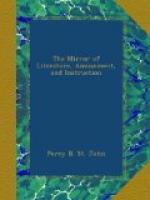* * * * *
THE NATURALIST.
* * * * *
DURATION OF LIFE.
It appears from well authenticated documents, that the mean term of Roman life, among the citizens, was 30 years—that is to say, taking 1,000 persons, adding the years together they each attained, and dividing the total by the number of persons, the result is 30. In England, at the present time, the expectation of life, for persons similarly situated, is at least 50 years, giving a superiority of 20 years above the Roman citizen. The mean term of life among the easy classes at Paris is at present 42. At Florence, to the whole population, it is still not more than 30.
We have gleaned these interesting facts from a review of Dr. Hawkins’s Elements of Medical Statistics; and as the subject is like human life itself, of exhaustless interest, we shall proceed with a few more:
Counties of England and Wales.
In 1780, the annual mortality of England and Wales was 1 in 40. By the last census (of 1821,) the yearly mortality had fallen to 1 in 58, nearly one-third. The rate of mortality is of course not equal throughout the country. According to Dr. Hawkins, this is mainly influenced by the proportion of large towns which any district or county contains. The lowest well-ascertained rate of mortality in any part of Europe is that of Pembrokeshire and Anglesey, in Wales, where only one death takes place annually out of eighty-three individuals. Sussex enjoys the lowest rate of mortality of any English county; it is there 1 in 72. Middlesex, on the other hand, affords the other extreme, 1 in 47; yet here, where the rate of mortality is higher than in any part of England, great improvements in the mean duration of life are taking place; for in 1811, the mortality was as great as 1 in 36. Kent, Surrey, Lancashire, Warwickshire, and Cheshire, are the counties where, next to Middlesex, the deaths are most numerous. The three last named counties enjoy many natural advantages, but these are more than counterbalanced by the number and density of their manufacturing towns. It is a circumstance well worthy of note, that the aguish counties of England do not, as might have been expected, stand high in the list. In Lincolnshire, the rate of mortality is only 1 in 62. Dr. Hawkins hesitates whether




